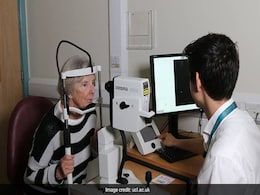Optical Coherence Tomography
- All
- News
-

AI Can Spot Parkinson's 7 Years Before Clinical Diagnosis, Study Finds
- Wednesday August 23, 2023
- Science | Edited by Nikhil Pandey
Detailed 3D retina images with high resolution feature distinct markers capable of indicating the potential risk of Parkinson's disease in an individual.
-
 www.ndtv.com
www.ndtv.com
-

This New AI-Based Technique Can Detect Heart Conditions, May Help Avert Heart Attacks
- Saturday July 23, 2022
- Edited by Gadgets 360 Newsdesk
In what may lead to the development of new treatments for heart diseases, researchers have created a novel artificial intelligence (AI) technique that can detect plaque erosion in heart arteries. The technique uses optical coherence tomography (OCT) images to monitor arterial plaque.
-
 www.gadgets360.com
www.gadgets360.com
-

New Technique Allows Viewing Of Cells And Tissues Under Skin
- Sunday March 20, 2016
- Health | Indo-Asian News Service
A team of US researchers has developed a new imaging technique for viewing cells and tissues in three dimensions under the skin, which may one day allow doctors to evaluate how cancer cells are responding to treatment.
-
 www.ndtv.com
www.ndtv.com
-

AI Can Spot Parkinson's 7 Years Before Clinical Diagnosis, Study Finds
- Wednesday August 23, 2023
- Science | Edited by Nikhil Pandey
Detailed 3D retina images with high resolution feature distinct markers capable of indicating the potential risk of Parkinson's disease in an individual.
-
 www.ndtv.com
www.ndtv.com
-

This New AI-Based Technique Can Detect Heart Conditions, May Help Avert Heart Attacks
- Saturday July 23, 2022
- Edited by Gadgets 360 Newsdesk
In what may lead to the development of new treatments for heart diseases, researchers have created a novel artificial intelligence (AI) technique that can detect plaque erosion in heart arteries. The technique uses optical coherence tomography (OCT) images to monitor arterial plaque.
-
 www.gadgets360.com
www.gadgets360.com
-

New Technique Allows Viewing Of Cells And Tissues Under Skin
- Sunday March 20, 2016
- Health | Indo-Asian News Service
A team of US researchers has developed a new imaging technique for viewing cells and tissues in three dimensions under the skin, which may one day allow doctors to evaluate how cancer cells are responding to treatment.
-
 www.ndtv.com
www.ndtv.com




